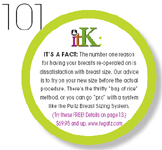- General Dermatology
- Eczema
- Chronic Hand Eczema
- Alopecia
- Aesthetics
- Vitiligo
- COVID-19
- Actinic Keratosis
- Precision Medicine and Biologics
- Rare Disease
- Wound Care
- Rosacea
- Psoriasis
- Psoriatic Arthritis
- Atopic Dermatitis
- Melasma
- NP and PA
- Skin Cancer
- Hidradenitis Suppurativa
- Drug Watch
- Pigmentary Disorders
- Acne
- Pediatric Dermatology
- Practice Management
- Prurigo Nodularis
Article
Implants 101
So you want to get breast implants. Whether it was a difficult decision or a no-brainer, you've got more choices to make related to the actual procedure, so we enlisted the help of Edward Pechter, M.D., F.A.C.S., board-certified plastic surgeon, based in Valencia, California, to explain. Here are the four basic - but critical - decisions you need to make when you choose to have breast implant surgery.

01. SALINE OR SILICONE?
Dr. Pechter supports the American Society of Plastic Surgeons (ASPS) position that silicone gel-filled implants offer a more natural feel than saline implants. The gel feels and moves much like natural breast tissue. To this point he adds, "...saline implants sometimes form ripples, like the ridges of an old-fashioned washboard, which can be felt - or even seen under the skin. This is mainly a concern for thin and small-breasted women." He adds that this occurrence is less noticeable in women who have a fair amount of breast or fatty tissue to begin with.

2. SIZE AND SHAPE
According to Dr. Pechter, the decision on size includes various factors that are, in part, determined by a woman's "tissue characteristics," including how much stretch she has in her skin, the width of her chest, and the amount of fatty tissue she has under the skin.
Then, of course, there's patient preference. Dr. Pechter points out that "while tissue characteristics certainly play a role, many plastic surgeons, myself included, feel that the patient's desire regarding size is far and away the most important consideration. If a woman desires large implants, and she understands the implications of such, in terms of the long-term effects on her breasts, then size should be her personal decision."
Shape, Dr. Pechter explains, is determined to a large extent by the inherent form of the breasts. But, he adds, "Shape can also be influenced by implant dimension: Implants of an identical size can result in a different appearance, depending on whether her doctor uses high-profile implants (narrow but producing significant projection) versus low-profile implants (wider but with less projection.)" He also adds that breast lift (mastopexy) can significantly reshape breasts that sag.
03. LOCATION
Breast implants can be placed over or under the chest (pectoralis major) muscle. According to Dr. Pechter, over-the-muscle placement results in less pain, while under-the-muscle placement offers less interference with mammograms, less chance of being able to feel the implant, better long-term support, and perhaps less chance of capsular contracture, the most common complication of breast augmentation surgery, which distorts the appearance of the breast. Dr. Pechter adds that "there is also a further distinction between a complete and partial approach with the sub-muscular method." Ultimately, choosing the appropriate implant location, he points out, is a decision best made between you and your surgeon, based on advantages and disadvantages of each approach, relevant to your personal anatomy.
4. INCISION TECHNIQUE

If the incision goes under the breast or around the nipple, your doctor can directly see the pocket for the implant as it's created, which maximizes the chance for proper implant positioning. If subsequent operation becomes necessary, the same incision can be re-used. However, while the incision is well-hidden around the nipple, it is more apparent under the breast. If your incision goes through the armpit, it may be well-hidden, but other challenges present themselves. It's harder to place the implant properly, it's difficult to insert a silicone implant of any size and there's a small risk of damaging nerves traveling to arms. And finally, an incisional approach through the belly button has multiple limitations. Not only is it impossible to insert silicone implants with this approach, but placement from this larger distance is difficult and subsequent procedures require one of the other incisions.





